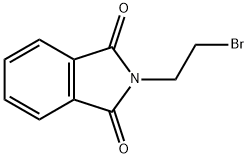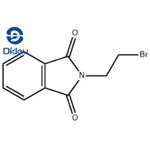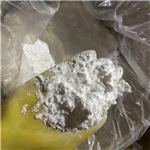Chemical Properties
white powder
Uses
N-(2-Bromoethyl)phthalimide is an intermediate used in organic synthesis. It can react with phenyl magnesium bromide to get 2-(2-bromo-ethyl)-3-hydroxy-3-phenyl-isoindolin-1-one.
Synthesis Reference(s)
Journal of the American Chemical Society, 71, p. 2425, 1949
DOI: 10.1021/ja01175a052Organic Syntheses, Coll. Vol. 1, p. 119, 1941
reaction suitability
reagent type: cross-linking reagent
Synthesis
In a 250 mL two-necked round-bottomed flask, 50 mmol of 3-hydroxy-1H-isoindol-1-one, 150 mmol of 1,2-dibromoethane, 2.0 g of tetrabutylammonium bromide (TBAB) as a phase-transfer catalyst, and 120 mL of dimethylformamide (DMF) were sequentially added. The reaction mixture was heated to 50-80 °C and maintained at this temperature for 5 h, during which the progress of the reaction was monitored by thin-layer chromatography (TLC) [unfolding reagent ratio: petroleum ether:ethyl acetate = 5:1 (v/v)]. After completion of the reaction, the solvent was removed by distillation under reduced pressure. Ice water was added to the residue and a large white solid was precipitated, which was filtered, washed and dried. The resulting solid was transferred to a 250 mL dry round bottom flask and recrystallized by adding 30 mL of methanol. After cooling to room temperature, the crystals were precipitated, and after filtration and drying, 10.3 g of white solid product was obtained in 81% yield.
Purification Methods
The following is to be carried out in an efficient FUME HOOD. Dissolve the compound (180g) in CS2 (500 mL) by refluxing for 15minutes (to cause the separation of the most likely impurity, 1,2-diphthalimidoethane), filter and evaporate under reduced pressure. The product forms light tan crystals (m 78-80o). Recrystallise it from EtOH (charcoal) [the compound (50g) is dissolved in hot 75% EtOH (200mL), boiled for ca 10 minutes, carbon is added (5g, Norite), filter and cool to 0o], to give white crystals (40g) which can be recrystallised (m 80-81o); and further recrystallisation gives m 82-83o. [Salzberg & Supniewski Org Synth Coll Vol I 119 1932, Landini & Rolla Synthesis 389 1976, Beilstein 21/10 V 275.]
References
[1] Journal of Heterocyclic Chemistry, 2008, vol. 45, # 5, p. 1371 - 1375
[2] Dalton Transactions, 2013, vol. 42, # 44, p. 15735 - 15747
[3] Patent: CN105237451, 2016, A. Location in patent: Paragraph 0051; 0055; 0056; 0057; 0058
[4] Journal of Medicinal Chemistry, 2006, vol. 49, # 26, p. 7826 - 7835
[5] Journal of Organometallic Chemistry, 2018, vol. 868, p. 154 - 163







